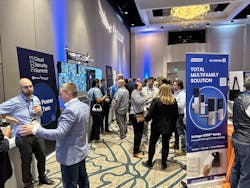Eagle Eye Networks filling gaps in product offerings to help integrators
AUSTIN -- Since the pandemic has waned, executives at Eagle Eye Networks have been working to fill gaps in its product lines and services as the cloud security innovator is poised to grow its footprint globally.
EEN’s growth plans, along with input from dealers and integrators, have culminated in some new products and services released this year. Here’s a rundown of what EEN Director of Product Matrketing Cooper Briscoe shared at the company’s Cloud Security Summit in Austin that would be of interest to dealers and integrators.
Eagle Eye Anywhere: At the Cloud Security Summit, the company launched Eagle Eye Anywhere, a combination of an outdoor-rated cabinet and surveillance camera that doesn’t require a bridge or CMVR. The unit can be placed anywhere without power or Internet, and it comes with solar technology so the unit can function independently.
The setup is ideal for locations such as a remote parking lot, construction site, golf course or other areas where infrastructure or location is challenging. It could be used, for example, by property managers who are dealing with illegal dumping or other illicit activity on their property. “And when you combine it with the analytics, now you're getting notifications based on things happening and starting to catch people a little more,” Briscoe says.
Camera Direct Complete: Announced at ISC West this spring, Briscoe says this is an economical direct-to-cloud solution that is ideal for customers who only need a few cameras per location and want to minimize their initial investment. Functionality has been expanded to eliminate the need for a bridge or CMVR.
Dealers or integrators can offer the service as a standard CAPEX or OPEX model through CDC. Brisco says these options are important when resellers are selling a client on an access control system and they’re on the fence about adding cameras. Users can add cameras or even direct cameras to existing sub-accounts that use bridges so they can be mixed and matched.
“We’ve eliminated a lot of costs and a footprint on site, and if we allow them to purchase it as an OPEX model it’s almost no upfront money to tap a recurring revenue stream where they pay for the camera as a subscription,” Briscoe says. “If they to add additional cameras or other sites, they’re already set up.”
Eagle Eye QL Stream: Briscoe also explained the logic behind EEN’s new capabilities with live local video, which he says had been less than ideal in the past. Although preview streams are a way to save bandwidth in cloud video, that may have limitations for some clients.
“It's been an issue for us over time to the extent where some resellers have said, ‘Hey, if my customer demands live local video and like a video wall and it needs to be high resolution, low latency,’ they will look for other options,” Briscoe says.
QL Stream gives EEN users the ability from the bridge or CMVR on-site to pull the RTSP stream directly off the camera and utilize that for high-quality local video. QL Stream is utilized across the EEN Cloud VMS, including the EEN Web App, Viewer mobile app, Local Display Station, Bridge HDMI Local Display, and numerous third-party solutions -- including video walls and spot monitors.
The result is enhanced video quality and lower latency so that a business owner or security professional can view or playback the video locally, whether it’s on a spot monitor, manager display, video wall, a browser, or the EEN Viewer mobile app.
“Is it a video wall? Or is it just somebody who wants to pull their iPad out and not look at the preview stream? What is the use case?” Briscoe says. “And then we just matrix it out to all five of our different solutions.”
Integration with Immix: EEN recently announced a partnership with Immix, a global firm that provides professional video monitoring services in a central-station environment. EEN historically has not been able to send alarms or events that are video generated or system generated through the professionally monitoring setting, Briscoe says.
“If you live in the world of central station monitoring you know that 97% of alarms are false alarms. It's a nuisance and the operators must deal with a lot of churn and false alarms,” he explains. “So, the central stations charge you money for those false alarms.
“Now we have the capability to take an AI-filtered event and say, do not send through motion events, send only a person or vehicle that’s been detected. It’s kind of a game-changer to be able to marry that with Immix. They're in almost all the countries on the planet and they have a heavy adoption.”
EEN is “without a doubt” having additional conversations with other large monitoring firms and that’s a “big part of our open API story and the fact that we want to be easy to integrate with,” Briscoe adds. “We don't want to be pay to play. We want to be an ecosystem that's easier for people to partner with.
John Dobberstein is managing editor of SecurityInfoWatch.com and oversees all content creation for the website. Dobberstein continues a 34-year decorated journalism career that has included stops at a variety of newspapers and B2B magazines.
About the Author
John Dobberstein
Managing Editor/SecurityInfoWatch.com
John Dobberstein is managing editor of SecurityInfoWatch.com and oversees all content creation for the website. Dobberstein continues a 34-year decorated journalism career that has included stops at a variety of newspapers and B2B magazines. He most recently served as senior editor for the Endeavor Business Media magazine Utility Products.

